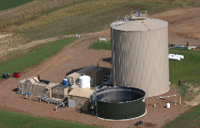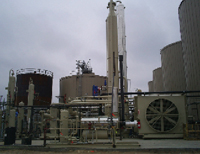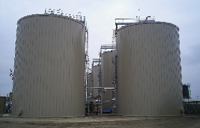
A massive digester project in
Texas will soon be producing one billion cubic feet of bio-gas a year –
using eight 916,000 gallon tanks – from the manure of some 10,000 dairy
cows.
A massive digester project in Texas will soon be producing one billion cubic feet of bio-gas a year – using eight 916,000 gallon tanks – from the manure of some 10,000 dairy cows.
The dairy industry is big in Erath County, Texas. Illustrating that importance is ‘Moola’, a larger than life sized fiberglass Holstein cow statue that sits at one corner of the town square of Stephenville, the Erath County seat.
While there has been a shift of dairies in Texas in recent years – notably to the western part of the state, Erath County is still the leading dairy county – and proud of it. Directly below Moola’s udder is a sign proclaiming that the county sells some $220 million worth of milk a year, servicing the large Dallas/Fort Worth market, about 100 miles to the northeast.
There are thousands of dairy cattle on a number of large farms in the county who generate that milk – and along with that milk, they’re also generating millions of pounds of manure every year.
Until recently, that manure was managed through spreading on local
crop land or through large scale composting facilities.
But Microgy Inc, a subsidiary of New Hampshire-based Environmental Power Corporation, is now completing construction of a massive project that will see the company generate biogas (2/3 methane, 1/3 carbon dioxide) from the manure from 10,000 dairy cows, which is then processed into pipeline-grade methane. Microgy is designing and building the facility, called Huckabay Ridge, and will also own and operate it.
The sheer scale of the project is impressive – it will handle a huge amount of manure. It has eight 916,000 gallon digesters, and is expected to produce one billion cubic feet of biogas a year with an energy content of 650,000 million BTU.
The Huckabay Ridge facility is located adjacent to Producers Compost Incorporated (PCI), a composting site that receives manure from over 20,000 cows. Microgy has signed an agreement with PCI providing the company with the exclusive right to source all the manure required by the Huckabay project from the composting facility.
 An aerial view shows the scale of the project. An aerial view shows the scale of the project. |
“If you look at the big picture, we’re basically in the middle of the composting process,” explains Mike Newman, director of plant operations for Microgy. “But instead of windrowing the manure, we’re putting it into our system to
produce biogas.
“Essentially what we are doing is taking the processing of manure to a higher level,” adds Dan Eastman, Microgy’s senior vice-president of business development in the U.S. southwest. “It’s what I like to view as the next generation of manure composting and processing in the United States.
“We’re taking the manure and putting it through a digester which in itself brings a lot of benefits, such as cooking it within a thermophilic range and killing a lot of the pathogens. The process adds value – we get biogas and it makes it a lot easier to compost the end material.”
Newman noted that there is already a well established system in place in Erath County that sees farms transporting their manure to a number of compost facilities. The compost facilities are complementary to manure land application, and help ease the environmental pressure on the region’s Bosque River watershed.
“We decided to site our project at PCI’s compost yard to capture a part of the available manure flow that was being gathered in the county,” he explains.
Their end goal is to obviously make a profit from the sale of the biogas being produced. But along the way, they will be helping dairy farms stabilize their operating and maintenance costs.
 The bio-gas is processed into pipeline-grade methane. The bio-gas is processed into pipeline-grade methane. |
“Environmental regulations are continuing to tighten up for the dairy industry and the dairies are looking at what will keep their O and M costs reasonable,” notes Eastman. “Utilizing Huckabay Ridge is one way they can do that.”
The dairies have choices, he noted. The options include buying or leasing more land (if it is available) to apply their manure and they can look at moving somewhere else where there is more land for manure application.
“Or they can truck it to the Microgy plant, and essentially be done with it,” says Newman. “Our facility is fully permitted and they can drop their manure off in a raw form and know that Microgy will treat it in a responsible, environmentally acceptable way – and that the regulators are not going to be coming back at them.
“After the dairies drop the manure off in our yard, a completely bermed, environmentally protected area, it’s now our responsibility. Any risk for that manure changes hands at our plant.”
Microgy has already built three manure digesters in the U.S. using this same type of technology, which is licensed from a Danish company. But until now, nothing has approached the scale of Huckabay Ridge.
“The system is very similar to what we’ve built in Wisconsin and what our Danish partners have built in Europe,” says Eastman. “But what we’ve done at Huckabay is applied economies of scale, and instead of having one or two tanks, we have eight tanks, to take advantage of the opportunity to digest more manure at this one single site.”
| Huckabay Ridge facility delivers first pipeline of natural gas Microgy announced in late March 2007 the initial delivery of pipeline-quality, renewable natural gas from the Huckabay Ridge facility in Stephenville, Texas. Currently, six of Huckabay Ridge’s eight digesters are producing bio-gas, and are in varying stages of start-up and operation, with the remaining two digesters beginning start-up. Bio-gas has now been processed through the on-site gas-conditioning and compression equipment and, once the commissioning process is finalized, Huckabay Ridge is expected to be generating at full capacity by the end of spring. “This phase of the Huckabay Ridge facility’s start-up represents a milestone in the implementation of our business plan as we pursue our goals of accessing the commercial mainstream with our premium value renewable natural gas (RNG),” says Rick Kessel, president and CEO of Microgy’s parent company, Environmental Power. “All this is in addition to the environmental “Now the process shifts to demonstrating fully reliable operation. I am very confident in the Microgy team and their consultants and fully expect that they will be able to achieve this important objective in time to meet our projected commercial operation date,” adds Kessel. “The experience of the start-up of Huckabay will be invaluable in our project rollout at the other large-scale facilities under development in Texas, California and other key markets.” |
Huckabay, he said, is really the third iteration of the technology. The first and second iterations were used on digester systems on three Wisconsin dairies: Five Star Dairy, Norswiss Dairy and Wild Rose Dairy.
“We’ve taken every bit of technology and the learnings from those sites, and basically multiplied it by eight for Huckabay,” Newman says.
One of the learnings involved the substrate tanks, which at the Wisconsin projects were much smaller. These substrates – made up of fats, oils and greases – help enhance the biogas production process.
“We learned that if we can get a more homogeneous blend of substrates coming in, we can control the process better. So we have a 700,000 gallon substrate tank on this project, and we’re already seeing the benefits and advances of bringing more material in and seeing more consistent substrate material going out and into the digesters.”
With the Five Star, Norswiss and Wild Rose projects, the manure basically comes out of the barn and goes directly into the digesters. Microgy has taken that experience, plus existing technology in the ag industry, and added to it, building a large slurry pit at Huckabay that allows them to get that more consistent manure mix going the digesters. That consistency is carried right through the system. “One of the differences we see here vs. the Wisconsin projects is that we’re a lot more capable of repeating, day in and day out, what we are doing to produce biogas.”
Manure enters the process at Huckabay directly from the dairies. It’s trucked in and is either dumped directly into a hopper and then into the slurry pit or dumped onto a concrete pad, for use later. When fully operational, the plant will require 10 truckloads of manure daily. They expect to be dealing with between 12 and 15 dairies for that manure.
Interestingly, while most farm operations are usually seeking to get moisture out of the manure, Microgy actually adds moisture.
“We get a more consistent solids level by adding water with a hydropulser, so we are really re-hydrating the manure,” notes Newman. “We’re looking to feed each one of the digesters out of the slurry pit with a consistent volume of solids.”
The big difference with Huckabay Ridge, vs. the Wisconsin projects is that Microgy will be cleaning the biogas and putting it directly into the pipeline. With the other projects, the biogas is sold to Dairyland Power co-operative, which uses the gas to generate renewable electricity.
Microgy cleans the gas using a scrubber system supplied by South-Tex Treaters Inc, which sits on a skid pad.
“The setup looks no different than if you drove out to a natural gas well in West Texas,” says Eastman. “South-Tex Treaters look at what gas comes out of the ground, and determined what goes on the site in terms of scrubbing equipment. They basically did the same thing at Huckabay Ridge.”
A gas line comes off each of the digesters, going into a central line that leads into the scrubber. Once the gas is scrubbed – with carbon dioxide and traces of water vapor and hydrogen sulfide removed – they pressurize it
to 1000psi before putting it into
the pipeline.
“We have a set of commercial gas standards that we have to meet,” says Newman. “The pipeline company has its own quality control systems, and if we don’t meet those standards, they just shut the gate and stop taking gas, like they would with a natural gas well when there’s a problem.”
 Eight tanks, each holding up to 916,000 gallons, contain the manure from some 10,000 dairy cows. Eight tanks, each holding up to 916,000 gallons, contain the manure from some 10,000 dairy cows. |
With eight digesters producing biogas, and a well set-up scrubbing system, that is a problem they do not expect to have.
The beauty, and the difference, from the hydrocarbon-based natural gas wells in Texas, or anywhere else, is that Microgy’s biogas is renewable. As long as the manure comes in the plant gate, they have a source of supply. “Unlike those gas wells out in West Texas, we will never run dry as long as those diaries are operating and bringing their manure to our plant.”
In terms of revenue from that gas, Microgy takes all the risks – and presumably the rewards – from selling the biogas. Since it is sending the gas into an interstate pipeline, it can either sell it on the spot market or sell it forward on short or long term contracts.
“That’s always the question you have,” says Eastman. “You hate to lock in the price for too long, only to have the market price double. And you hate to lock in for too short a time – the market could fall through the floor, and you regret not having locked the price in for longer.”
Microgy and its parent company, Environmental Power, have carried out sophisticated market analysis to try to maximize biogas revenues. The end result: they have opted to strike a deal with the Lower Colorado River Authority (LCRA) for an 18 month period. LCRA will be using this “green gas” to
produce energy for 43 city-owned utilities and electric co-operatives, which serve more than one million people in Central Texas.
There also may be an added bonus. LCRA and Microgy have agreed to work together regarding the potential purchase by LCRA of carbon offset credits and renewable energy credits produced by the facility.
Once it’s fully operating, Huckabay will generate up to two million cubic feet of renewable natural gas per day for use in any of LCRA’s three natural gas-fired power plants, and is also expected to generate approximately 200,000 metric tons of carbon offset credits per year. That translates into the equivalent of 12,700 gallons of heating oil per day.
The fact that the company had done digester projects before worked in their favor in getting the necessary permitting, and getting construction underway. “The permitting process is what it is – but the state has been very helpful in working with us to make this project work,” says Eastman. “We did not see stiff objection to the project. We’re really positioning ourselves to be an environmental benefit – we like to take the view that we are what is next for the dairy industry, and can help them keep on running their dairies.”
| Outlook positive for manure to bio-gas Things look very positive right now for Microgy and its manure-to-biogas business approach, says Dan Eastman, Microgy’s senior vice-president of business development in the U.S. southwest. “At the end of the day, the dairy industry recognizes that environmental issues have to be handled and Microgy is now a dominant player in this space. We’re very enthusiastic and excited about the prospects for building many digesters across North America.” Al Morales, executive vice-president of Microgy’s parent company, Environmental Power Corporation, echoed Newman’s comments. “This market has significant potential, and we are actively evaluating a number of other potential projects of similar scope.” It looks like the company could be very busy over the next few years. As well, Microgy has announced lease and manure handling agreements with several California dairies for the development of renewable gas facilities. At full operation, these facilities are expected to generate approximately 8000mcf/day, an amount sufficient to fulfill Microgy’s saleable gas rights under a recently announced long term purchase contract with Pacific Gas & Electric. With California recently enacting mandates to reduce greenhouse gases, these carbon credits are expected to be a significant part of the business equation, with an estimated annual value of over $3 million based on current prices |